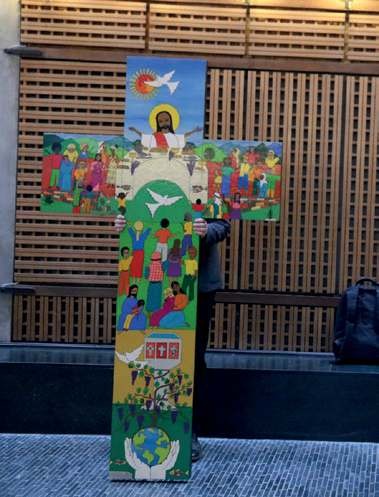Medieval History brought to life in Fife
Thomas Baldwin reports on one church’s attempt to bring history to life ahead of the opening of a new pilgrim route.
PARISH NEWS

Photo: iStock
A CHURCH has helped to bring medieval history to life using the backdrop of their own historic building in the run up to the opening of the Fife Pilgrim Way later this year.
Members of Markinch Parish Church welcomed around 80 visitors to the 12th century site in January for a talk about what was once one of the holiest pilgrimages in Britain.
Local historian Bruce Manson spoke on ‘Medieval Markinch: A TripAdvisor Guide for Pilgrims’, whilst tours were also off ered around the medieval site.
The event was the first in a series planned by the Fife Coast and Countryside Trust, designed to help people to become more familiar with the background to the sacred route.
Set against the background of the church’s 900-year-old tower, Mr Manson looked at the building’s history and explored what pilgrims would have seen as they passed through the town on their way to St Andrews.
Based on evidence of so called ‘spittals’ or pilgrim hostels along the holy route, which for hundreds of years held deep spiritual meaning, he showed that at one time there were many diff erent paths crossing Fife used by religious visitors.
Described as “a work of art in itself”, an intricate display of knitted scenes depicting the daily life of monks as well as pilgrims was also exhibited, which showed snapshots of the daily lives of the people who would have been connected to the walk.
The crafted figures were designed by the Rev Elizabeth Fisk and made by members of Culross Abbey, who loaned them to Markinch for the exhibition.
The church worked with two other groups locally, the Community Council and the Markinch Historical Group, to put together the event.
The 70-mile route will begin in Culross and North Queensferry via Dunfermline and end in St Andrews.
Action Together of Churches in Scotland will work with the Fife Coast and Countryside Trust to encourage churches to work ecumenically and with their local communities in preparing to welcome those who use the route, and the Trust is running a series of community events over the coming year to highlight the new route.
For more details of events go to the Fife Coast & Countryside Trust website or follow the Fife Pilgrim Way on Facebook or Twitter.
WORLD NEWS
’DAILY SQUEEZE’ FOR PERSECUTED CHRISTIANS
Most of the 200 million Christians globally under pressure for their faith don’t experience violence but a ‘daily squeeze’ which is more insidious and – if left unchallenged – can lead to violence, MPs and others heard at the launch of Open Doors’ World Watch List 2018 in the UK Parliament.
Religious persecution around the world is growing both in scale and severity, Open Doors’ CEO Lisa Pearce said during the presentation of the report ‘Death by a thousand cuts: The rise of non-violent persecution as a tool of oppression’.
According to the report, the most dangerous countries to live in as a Christian are also those which are ‘specialists’ in ‘the squeeze’: the pressures a Christian experiences in their day-to-day life – from education and work to family life – from cradle to grave. These countries use a variety of tools including surveillance, arrests, discrimination and unjust laws, to grind down the Christian community in the hope Christians will disappear. When this pressure is used eff ectively, it can be more insidious than violence, Open Doors says.
The pressure on freedom of religion or belief, left unchallenged, can turn into violent persecution for both Christians and those of other religious minorities and of no faith too. Lisa Pearce said Western governments continue to chronically underestimate the pressure religious freedom is under around the world, and the importance it has.
The parliamentarians were told that the upcoming meeting of the Commonwealth heads of government in London in April is an opportunity to address this issue. Eight of the 50 countries on the World Watch List where it is most difficult to live as a Christian are members of the Commonwealth: Bangladesh, Brunei, India, Kenya, Malaysia, the Maldives, Pakistan and Sri Lanka.
(World Watch Monitor)
WCC CELEBRATES 70 YEARS
The World Council of Churches (WCC) celebrates its 70th anniversary this year. This is an opportunity to mark the achievements of the past 70 years in working for Christian unity and action, and to look to the challenges ahead as a fellowship of churches responding to God’s call for unity, mission, justice and peace.
All member churches (including the Church of Scotland) and ecumenical partners are encouraged to take part in the anniversary by sharing stories, prayers or songs, organising or hosting events in their own context, bringing the WCC anniversary exhibition to their own venue or event, and by choosing a day for celebrating the anniversary, preferably on August 2, which marked the opening of the 1st Assembly in Amsterdam and the formal constitution of the WCC.
(WCC)
UNITY CROSS
A Salvadoran Cross that is a now an icon of Christian unity was dedicated and placed in the World Council of Churches’ Chapel in Geneva, Switzerland on the first day of the Week of Prayer for Christian Unity.
The 2m-high cross was created for the joint Catholic-Lutheran Commemoration of the 500th anniversary of the Reformation in Lund and Malmö, Sweden, on October 31 2016. It is the work of El Salvadoran artist Christian Chavarría Ayala, and was present during the signing of a Lutheran-Catholic Joint Statement signed by Pope Francis and then Lutheran World Federation President, Bishop Munib A Younan.
“On behalf of the World Council of Churches, we receive this cross as a gift of communion”, said World Council of Churches (WCC) general secretary, the Rev Dr Olav Fykse Tveit at the ceremony.
“May the historical step that it symbolises remind us that Christ’s cross transforms our conflict into communion, and we are reconciled as one creation, joined by the one sprit of God and Creator.” (WCC)

PhotosIvars Kupcis/WCC
For more news follow us at www.lifeandwork.org